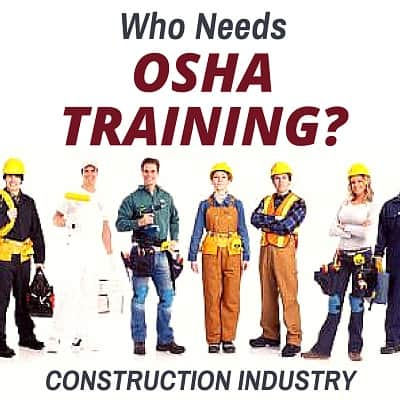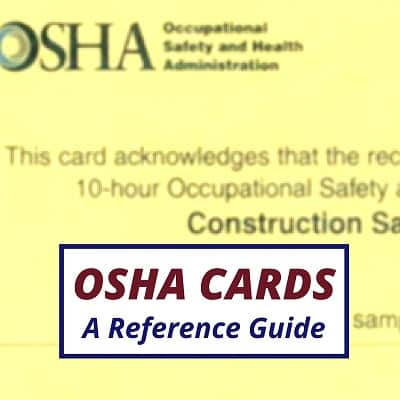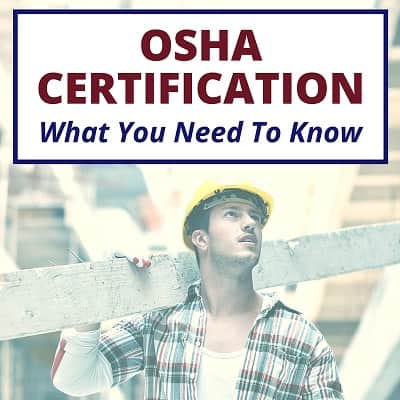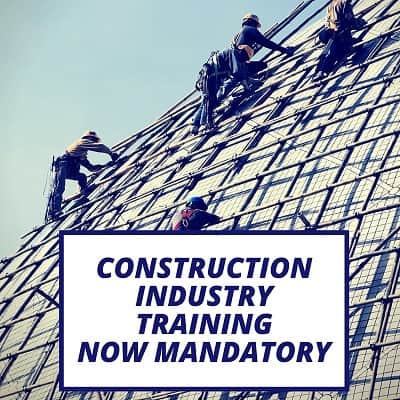Who Needs OSHA Construction Training?

About OSHA Training
Since the 1970s, OSHA (the Occupational Safety and Health Administration) has worked to reduce workplace injuries and fatalities through training and safety standards. Many of these standards specifically require employers to ensure that workers are trained on the hazards they may come into contact with. OSHA has developed a summary in Training Requirements in OSHA Standards, but at more than 250 pages, ensuring training requirements are fully met can be a daunting task.
For this reason, training can sometimes be a confusing topic, especially in the Construction industry — which experiences a significant number of worker fatalities each year. We hope that by answering a few questions about the Construction industry and OSHA training, we can answer the larger question of: "who needs OSHA 10-hour and 30-hour training?"
What Is a Construction Worker?
Under 29 CFR 1910, section 1910.12(b), OSHA defines "construction work" as "work for construction, alteration, and/or repair, including painting and decorating." Most other workers, such as those working on maintenance and upkeep of facilities, would be considered "general industry" workers.
That said, the definition can get tricky when it comes to large-scale maintenance work. Depending on the size and complexity, OSHA may consider some "maintenance" workers to be doing "construction work." OSHA has issued an official interpretation regarding maintenance workers that may be helpful for maintenance workers to determine whether or not they do construction work.
Classifying Construction Workers
Many workers doing the following work or holding the following job titles may fall under OSHA's umbrella for Construction.
Types of Construction Work
- Public & Construction Engineering
- Carpentry
- Plasterwork
- Scaffold, Construction and Concrete
- Stone Work
- Roof Work
- Electrical Work
- Piping Work
- Tile, Brick and Block Work
- Steel Construction Work and Reinforcement Work
- Paving Work
- Dredging Work
- Glass Work
- Interior Finishing
- Machinery Installation
- Landscape Gardening
- Water Facilities Work
- Waste Facilities Work
Types of Construction Workers
- Boilermakers
- Carpenters
- Carpet Layers
- Dredgers
- Electricians
- Fire Sprinkler Installers
- Linemen
- Elevator Mechanics
- Fencers
- Glaziers
- Heavy Equipment Operators
- Insulation Installers
- Ironworkers
- Laborers
- Landscapers
- Masons and Stonemasons
- Millwrights
- Painters & Decorators
- Pile Drivers
- Plasterers
- Plumbers
- Pipefitters
- Sheet Metal Workers
- Tile Workers
- Truck Drivers and Teamsters
- Waterproofers
- Welders
Have questions about whether or not you are a construction worker or whether you're someone who needs OSHA training? Contact our safety experts at sales@usfosha.com, who can help make sure you get the most appropriate training for your particular work setting.
Why Is OSHA Training Vital for Construction Workers?
Since OSHA was founded on April 28, 1971, it has drastically reduced workplace fatalities. Through the standards OSHA set, including training requirements and safety standards, it has saved thousands of lives.
OSHA and researchers have identified four specific hazards in the construction industry that cause a large majority of fatal injuries; in fact, OSHA's Construction Focus Four are responsible for the majority of jobsite injuries and deaths.
The Construction Focus Four are as follows:
- Fall Hazards — Falls are the single most deadly hazard in the construction industry. They can occur off roofs, off scaffolding, through holes or on working surfaces.
- Caught In/Between Hazards — Caught-in or -between injuries occur when an employee is squeezed, caught, crushed, compressed or pinched between parts of an object or several objects.
- Struck-By Hazards — This category encompasses all hazards resulting in objects that move, fall or roll and strike a worker. It also includes when unsecured loads or flying objects hit workers. These hazards are particularly dangerous for those working around traffic or with heavy equipment.
- Electrocution Hazards — Electrical hazards are considered one of construction's deadliest workplace hazards. Training relating to electrocution focuses on de-energizing circuits and then ensuring that no charge remains.
All OSHA-Authorized Outreach training courses for Construction are required to cover these hazards in-depth.
What Is OSHA Outreach Training?
Workers who fall under the definition of "construction workers" must receive training about certain job-specific safety concerns, such as general safety & health provisions, personal protective equipment, fall protection and other topics as defined by OSHA standards.
To help workers who need OSHA training meet these training requirements, OSHA created the Outreach training program, which was developed to promote workplace safety and health by providing access to training by OSHA-Authorized trainers.
Outreach training, along with specific on-site instruction by the employer, will help employers meet many of the required training provisions under OSHA standards.
To make access to that training even easier, OSHA authorizes a limited number of trainers to provide online courses. The material covered in these courses reflects OSHA requirements for Outreach training and has the same timing requirements as a classroom course, but students have the flexibility to take their course on their own schedule.
USFOSHA's OSHA-Authorized online Construction courses are also some of the few available that are mobile-compatible, allowing workers to train using tablets or mobile phones. USFOSHA's Outreach training also includes animations and interactions, which help guide students through worksite hazards in an engaging way that helps the concepts "stick."
Outreach training results in the issuance of an official Department of Labor (D.O.L.) OSHA card, also known as an OSHA 10 or OSHA 30 card. Many workers carry these cards with them on the worksite, and in some cases, there are workers who need to carry their 10-hour or 30-hour OSHA card with them at all times as mandated by their state.
10-hour training (and the OSHA 10 card) is recommended for all construction workers. 30-hour training (and the OSHA 30 card) is recommended for any construction employee with supervisory or safety-related responsibilities.
For more information about the Outreach program, including requirements and frequently asked questions, visit OSHA's website.
Is OSHA Outreach Training Required?
Though some states, jurisdictions or individual employers may decide to require Outreach training or Department of Labor cards for Construction employees, it is important to understand that Outreach training is not specifically required by OSHA; as with all other OSHA training courses, it is a voluntary program.
This training also does not necessarily cover all training requirements found in OSHA standards. Employers are responsible for providing additional training on specific job hazards. Some workers may find that a combination of Construction, General Industry and on-site training is necessary. Each worksite and job will have unique training requirements, and it is entirely the employer's responsibility to ensure that all job hazards are fully explained through training.
The best authority for training requirements is OSHA itself, who has put together a comprehensive Training Requirements in OSHA Standards and Training Guidelines document for employers.
That said, OSHA Outreach 10-hour and 30-hour training courses are a fantastic way to create a solid baseline of standards training, and these courses help employers to meet these important training requirements in an efficient and controlled method. While OSHA considers Outreach training voluntary, many construction companies consider it an essential part of their safety program.
Is OSHA Outreach Training Required in My State?
Some states and counties have determined that Outreach courses are necessary for certain workers. More than 20 states have even adopted state-specific OSHA plans that include regulations and training requirements that are more extensive than federal OSHA standards.
Mandatory OSHA training requirements can vary depending on the nature of the job or the cost of the contract. Some requirements apply only to state-funded public works projects, while others apply to both public and private construction.
Some examples of locations where OSHA training is mandatory include:
- Connecticut
- Miami-Dade County, Florida
- Massachusetts
- Missouri
- Nevada
- New Hampshire
- New York
- New York City, New York
- Pennsylvania
- Rhode Island
- West Viriginia
Because mandatory OSHA training requirements are determined by state and local laws, the list above is subject to change. Contact your state OSHA office to learn more about specific training requirements for construction workers.
For states that do not yet have a requirement, it may only be a matter of time! State and federal regulators want to ensure that workers who need OSHA training get OSHA training. These regulators want to establish a baseline of safety training for workers before they even step foot onto a worksite.
OSHA-authorized training (and a Department of Labor card) is an effective and reliable way to prove that efforts have been made to inform workers of the most important construction site hazards.
For more information on OSHA training, including bulk pricing for purchases of two or more courses, contact sales@usfosha.com



